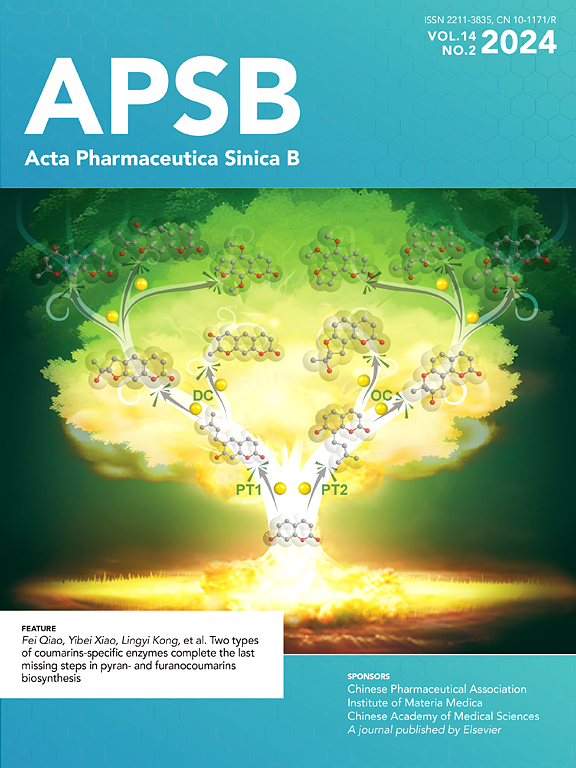ALKBH3-regulated m1A of ALDOA potentiates glycolysis and doxorubicin resistance of triple negative breast cancer cells
IF 14.6
1区 医学
Q1 PHARMACOLOGY & PHARMACY
引用次数: 0
Abstract
Chemotherapy is currently the mainstay of systemic management for triple-negative breast cancer (TNBC), but chemoresistance significantly impacts patient outcomes. Our research indicates that Doxorubicin (Dox)-resistant TNBC cells exhibit increased glycolysis and ATP generation compared to their parental cells, with this metabolic shift contributing to chemoresistance. We discovered that ALKBH3, an m1A demethylase enzyme, is crucial in regulating the enhanced glycolysis in Dox-resistant TNBC cells. Knocking down ALKBH3 reduced ATP generation, glucose consumption, and lactate production, implicating its involvement in mediating glycolysis. Further investigation revealed that aldolase A (ALDOA), a key enzyme in glycolysis, is a downstream target of ALKBH3. ALKBH3 regulates ALDOA mRNA stability through m1A demethylation at the 3′-untranslated region (3′UTR). This methylation negatively affects ALDOA mRNA stability by recruiting the YTHDF2/PAN2–PAN3 complex, leading to mRNA degradation. The ALKBH3/ALDOA axis promotes Dox resistance both in vitro and in vivo. Clinical analysis demonstrated that ALKBH3 and ALDOA are upregulated in breast cancer tissues, and higher expression of these proteins is associated with reduced overall survival in TNBC patients. Our study highlights the role of the ALKBH3/ALDOA axis in contributing to Dox resistance in TNBC cells through regulation of ALDOA mRNA stability and glycolysis.

alkbh3调节的ALDOA的m1A增强了三阴性乳腺癌细胞的糖酵解和阿霉素耐药性
化疗目前是三阴性乳腺癌(TNBC)系统治疗的主要方法,但化疗耐药显著影响患者的预后。我们的研究表明,与亲本细胞相比,多柔比星(Dox)耐药的TNBC细胞表现出糖酵解和ATP生成的增加,这种代谢转变有助于化学耐药。我们发现ALKBH3,一种m1A去甲基化酶,在调节dox抗性TNBC细胞中糖酵解的增强中起着至关重要的作用。敲低ALKBH3可减少ATP的产生、葡萄糖的消耗和乳酸的产生,暗示其参与介导糖酵解。进一步研究发现醛缩酶A (ALDOA)是糖酵解的关键酶,是ALKBH3的下游靶点。ALKBH3通过3 ' -非翻译区(3 ' utr)的m1A去甲基化调节ALDOA mRNA的稳定性。这种甲基化通过募集YTHDF2/ PAN2-PAN3复合物,导致mRNA降解,从而对ALDOA mRNA的稳定性产生负面影响。ALKBH3/ALDOA轴在体外和体内均促进Dox耐药性。临床分析表明,ALKBH3和ALDOA在乳腺癌组织中表达上调,这些蛋白的高表达与TNBC患者的总生存率降低有关。我们的研究强调了ALKBH3/ALDOA轴通过调节ALDOA mRNA的稳定性和糖酵解在TNBC细胞中促进Dox抗性的作用。
本文章由计算机程序翻译,如有差异,请以英文原文为准。
求助全文
约1分钟内获得全文
求助全文
来源期刊

Acta Pharmaceutica Sinica. B
Pharmacology, Toxicology and Pharmaceutics-General Pharmacology, Toxicology and Pharmaceutics
CiteScore
22.40
自引率
5.50%
发文量
1051
审稿时长
19 weeks
期刊介绍:
The Journal of the Institute of Materia Medica, Chinese Academy of Medical Sciences, and the Chinese Pharmaceutical Association oversees the peer review process for Acta Pharmaceutica Sinica. B (APSB).
Published monthly in English, APSB is dedicated to disseminating significant original research articles, rapid communications, and high-quality reviews that highlight recent advances across various pharmaceutical sciences domains. These encompass pharmacology, pharmaceutics, medicinal chemistry, natural products, pharmacognosy, pharmaceutical analysis, and pharmacokinetics.
A part of the Acta Pharmaceutica Sinica series, established in 1953 and indexed in prominent databases like Chemical Abstracts, Index Medicus, SciFinder Scholar, Biological Abstracts, International Pharmaceutical Abstracts, Cambridge Scientific Abstracts, and Current Bibliography on Science and Technology, APSB is sponsored by the Institute of Materia Medica, Chinese Academy of Medical Sciences, and the Chinese Pharmaceutical Association. Its production and hosting are facilitated by Elsevier B.V. This collaborative effort ensures APSB's commitment to delivering valuable contributions to the pharmaceutical sciences community.
 求助内容:
求助内容: 应助结果提醒方式:
应助结果提醒方式:


